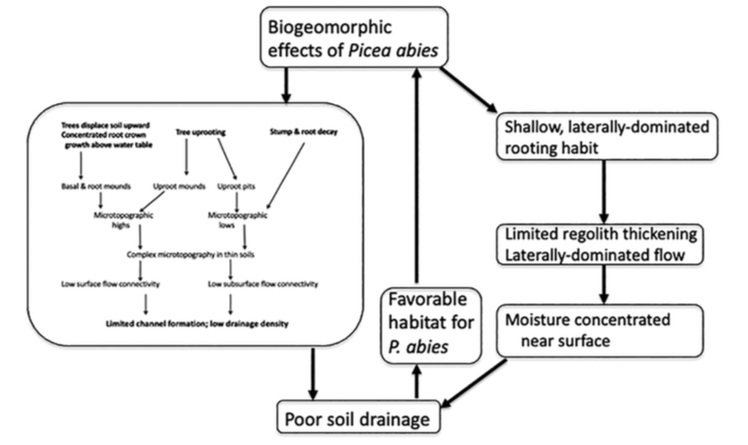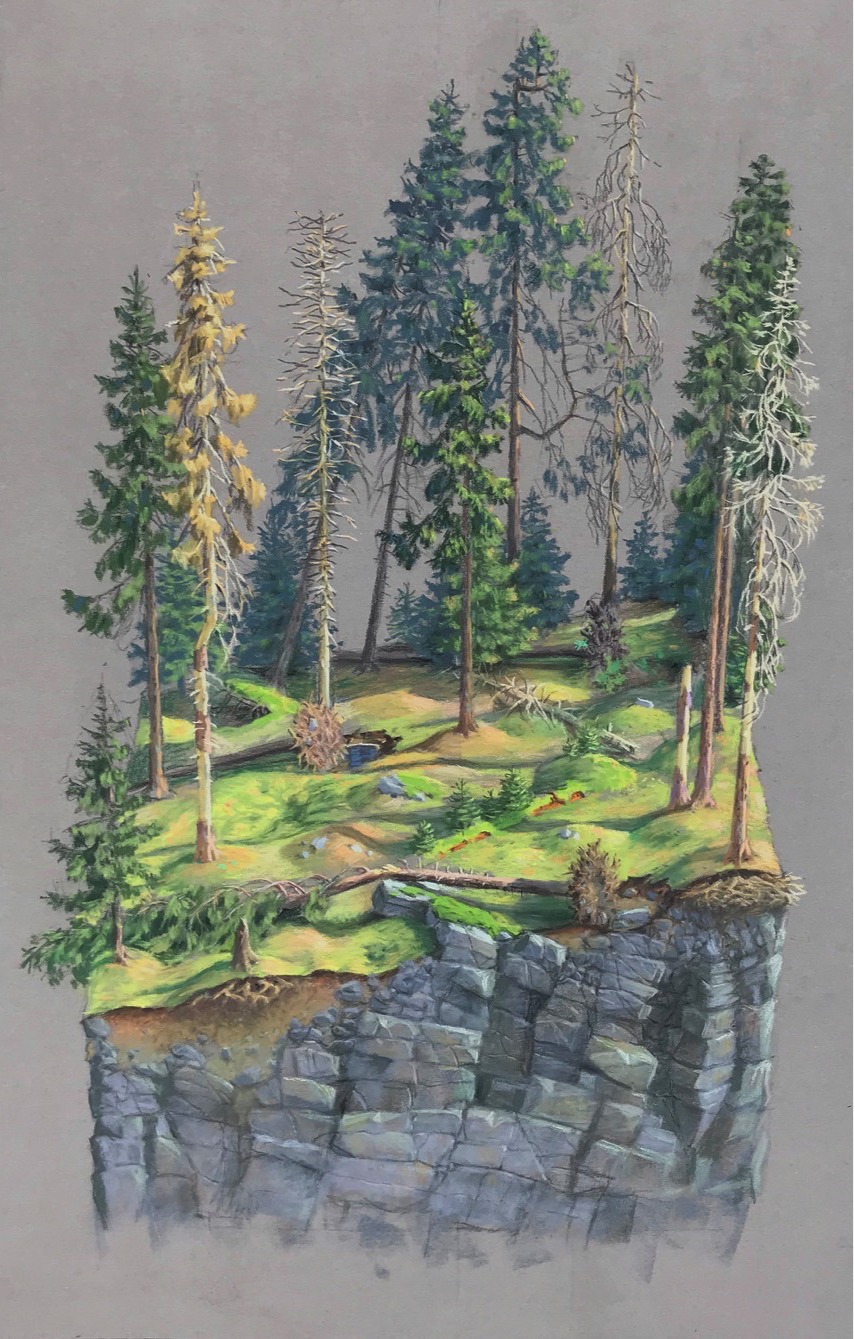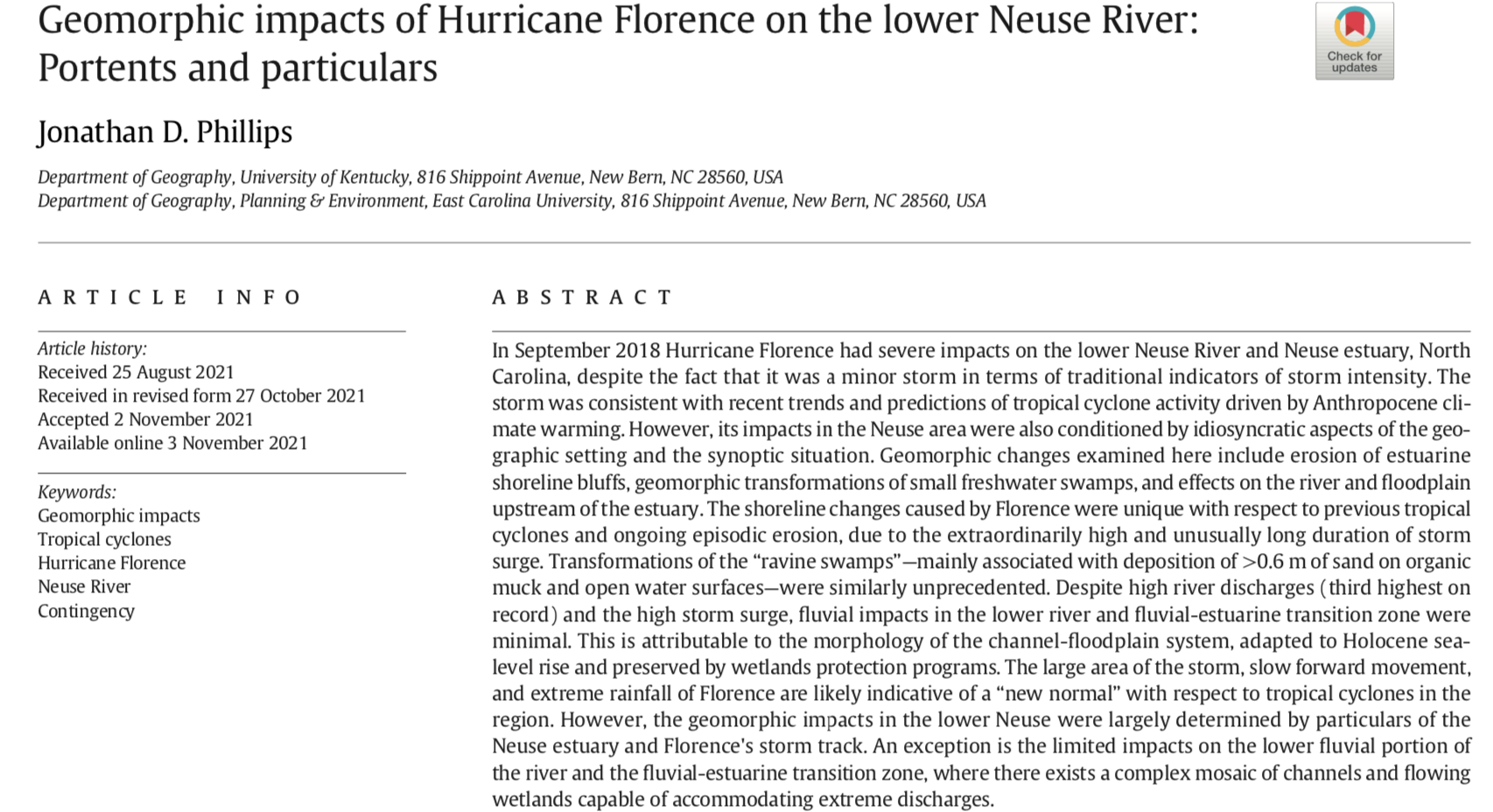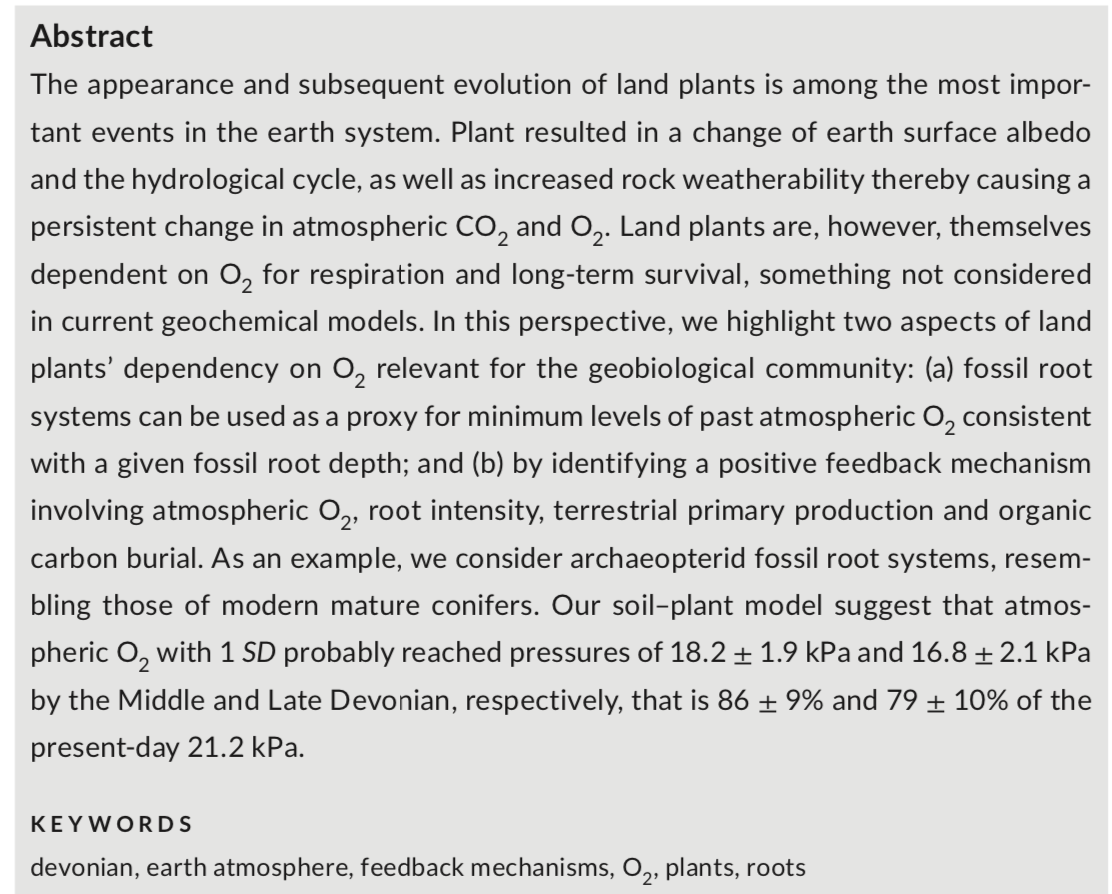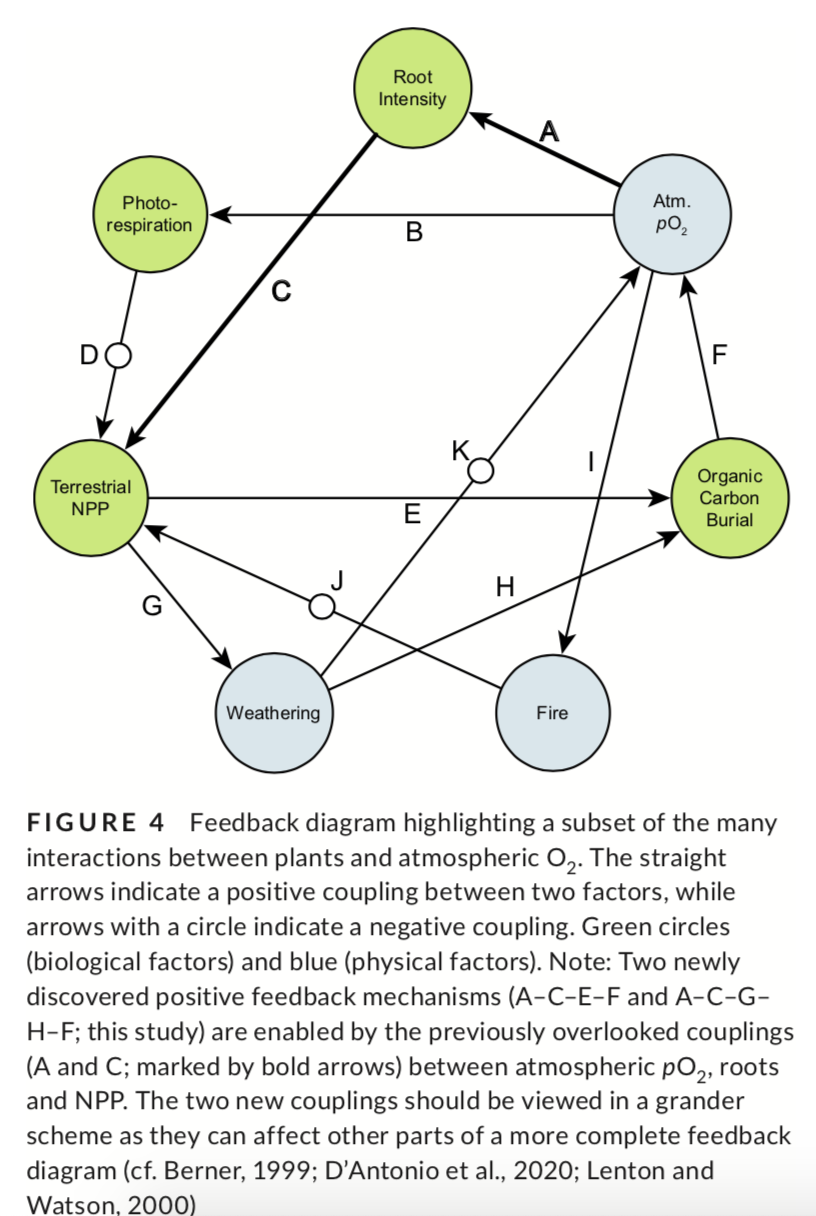THE ART OF SCIENTIFIC STORYTELLING (PART 3)
This installment continues the story of my collaboration (along with fellow scientist Pavel Šamonil) with Czech artist Petr Mores in combining visual art and science to tell the story of landscape evolution of forests, topography, and soils in the Šumava Mountains, Czech Republic (part 1; part 2). Here, I take a crack at brief narratives for four key parts of the story—trees, water, soil, and landforms. All the accompanying illustrations are from Mores—closeups are detail from his Biogeomorphological Domination piece, shown and analyzed in parts 1 and 2. Others are from preparatory work Petr did for that piece, and other examples of his paintings and drawings in the forests of the Czech Republic.
Tree story (general time scale: decades)

The tree story begins with establishment of a seedling, which is determined by production of seeds (cones) by an adult spruce, dispersal, predation, and the edaphic conditions where it alights. These include soil moisture and drainage or wetness, soil nutrients, and the presence of “nurse” logs. As compared to other trees, for Norway Spruce (Picea abies) soil drainage and nurse logs are especially important. Spruce does better on wet sites than competing trees, and recruitment often occurs on decaying spruce logs.

Tree growth, health, and reproduction are also influenced by edaphic conditions, competition from other spruce or other species, effects of pests or disease, and disturbances. These are influenced by episodic or time-dependent factors of weather and climate, and events such as droughts, windstorms, and fires.

A healthy, growing tree, in addition to getting taller and thicker, spreads roots with a predominantly lateral, disk-like root architecture, producing a basal mound and possible root mounds associated with large lateral roots. The tree continuously uses water drawn from the soil, transpires water vapor back to the atmosphere, and disperses water through the soil along living roots and channels or former roots. The tree also produces litter (needles, twigs, etc.), building a litter layer and adding soil organic matter.
Tree death has three major pathways. Trees that die in a standing position or are broken (trunk breakage) eventually leave a stump that decomposes. These may leave a depression as the wood rots and soil displaced by the tree to create a basal mound subsides. In some cases, a distinct stump hole is formed. A second pathway is harvesting, which has the same topographic effects, but no lying trunks or large logs.

Uprooting is the third pathway. An uproot pit is formed immediately by the soil and regolith pulled out with the rootwad. As material falls off the rootwad and the tree decomposes, an uproot mound forms adjacent to the pit. The pit-mound topography and its local effects on water flow, soil moisture, and organic matter accumulation influence edaphic conditions and seedling establishment.
The uprooting and standing death/breakage paths both produce lying trunks on the ground. These may become nurse logs for seedling establishment. The local mounding (from wood decomposition, moss growth, and sometimes sediment trapping) and nutrient supply from decomposition influence edaphic conditions and seedling establishment.

Water story (general time scale: hours to days)
A raindrop or snowflake falling towards the ground begins the water story. The drop either falls directly on the ground surface, or is intercepted—that is, lands on or is caught by plants. This intercepted water, if it is not evaporated, reaches the ground by drip from leaves/needles, or stemflow along the trunk or stem.

Once at the ground surface, either directly or via a plant, the water may infiltrate (soak into the soil). If it does not, it either remains on the surface as depression storage (e.g., puddles), or flows downslope as surface runoff or overland flow. Water in depression storage may will eventually evaporate, infiltrate, or possibly become part of surface runoff if puddles overflow.
Water that infiltrates—some flowing along plant roots and root channels--is available for plant uptake and use and some will be transpired to the atmosphere as water vapor. Before plant use or transpiration, infiltrated water may be stored as soil moisture in vegetation litter or mineral soil. Percolation as matrix or macropore flow within the soil and regolith, or as flow along roots, may deliver H2O to groundwater.

Subsurface water stored as soil moisture is subject to root uptake by plants, and (in ground water, macropores or conduits, or saturated soil), lateral downslope throughflow. Surface runoff is governed by topography, flowing away from higher local elevations and water-shedding peaks or mounds (such as basal mounds of trees and uproot mound), and toward depressions such as intermound swales, uproot pits, stumpholes, and channels.
The geomorphic and pedologic work of water as it moves through or is stored in the landscape includes weathering of bedrock, rock fragments, and soil; erosion, transport, and deposition of sediment; transport of solutes in surface runoff or groundwater, and translocation of material within soils and weathering profiles.

Soil story (general time scale: decades to millenia)
The soil story commences with the inherited geological parent material, either in intact bedrock form, or as rocky debris produced by glacial and periglacial processes. This is acted on by physical, chemical, and biological processes—particularly those associated with climate, water movement, microbes, plants, and gravitational forces.
The parent material is disintegrated and decomposed by weathering. This includes physical or mechanical weathering (mainly freeze-thaw and hydrofracturing or frost weathering), and chemical weathering, such as redox (oxidation and reduction) processes, hydrolysis, and dissolution. Biological weathering may be direct, via “rock-eating” organisms such as some lichens and cyanobacteria, and uptake of minerals via plant roots. Biota also facilitate (and in some cases are necessary for) many types of chemical weathering; mainly microbes (bacteria and fungi). Weathering continues to affect weathered rock and soil.

Organic matter is added to the soil by decomposition of dead organisms or parts thereof, especially plant litter and dead vegetation. Among decomposing organisms, microbes are particularly important. Living fauna also transform organic matter via consumption followed by defecation and other excretions.

Mass is translocated within soils and weathered material by water movement—this is largely gravity driven, but rising water tables and evapotranspiration can drive upward movement. The direction of translocation is strongly influenced by physical properties of the soil (e.g., permeability, porosity) and their spatial variations, and by macropores and roots. Net movement is generally downward, but water flow, and thus translocation, can occur in any direction. Biological translocation also occurs via burrowing, tunneling, mounding, and digging by fauna. Translocation may be dominantly physical (for example lessivage, where smaller particles are washed between larger ones; gravitational settling of rock fragments) or chemical (e.g., where material is dissolved at one location and precipitates at another; or food is consumed at one site and waste is excreted at another, such as by earthworms).
Physical biological translocation processes are also forms of bioturbation (physical disturbance or soil mixing). These also include displacement by tree uprooting and by subsurface and ground-level components of plant growth.
Additions to the soil include sediment deposition at the surface (via fluvial, mass wasting, or aeolian processes), and organic matter. Losses include surface or subsurface erosion, mass wasting, leaching (removal of dissolved material in runoff or groundwater), and loss of organic matter via decomposition and fire.

In general, over time soils will proceed from thin covers of minimally altered parent material or organic matter to more highly altered, thicker, and more organized (often called mature) states. Soil development may occur along these progressive pedogenetic pathways, or regressive pedogenetic pathways toward thinner, less organized and developed soils. Progressive and regressive trends are both reversible, and many soils reflect the past influences of both.
Topographic story (general time scale: centuries to millenia)
The “time zero” for topography in this case is the latest Pleistocene. The story starts on a template of broad scale topography inked to lithology, structure, tectonics, and geologic history. Weathering (as described in the soil story) acting on these inherited materials produces transportable material, which moves mainly via mass wasting, fluvial processes, and bioturbation.

As weathering proceeds, the landscape is sculpted by erosion, sediment transport, and deposition. Glacial and periglacial processes were important just before and at the very beginning of the story. Slope (mass wasting) and fluvial processes have dominated since.
A fluvial system of rivers and streams developed, with channels occupying inter-ridge valleys and glacially carved troughs. Channels extended upslope, but only on a limited basis. Runoff from summit areas and upper slopes is not well-connected due to the complex local and microtopography. Subsurface flow, with a strong lateral component (again strongly affected by the trees), dominates over surface runoff in these areas. Runoff is generally slow and drainage relatively poor, maintaining moist conditions in the landscape.
Locally, spatially complex hummocky microtopography developed, largely via the biogeomorphic effects of trees, via basal mounding (and intermound swales), tree uproot pit-mounds, and other effects. The local details of this topography are dynamic, but the overall surface complexity is maintained by biomechanical effects of trees and the low connectivity of surface and subsurface runoff.



